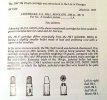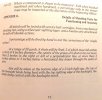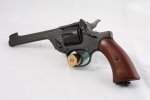The Webley & Scott Mark IV .380 Revolver - reprinted from The Fouling Shot by permission.
By the 1930s the British Army was mostly a conscript force, its career officer and NCO cadre having been decimated during the Great War. Tommy Atkins no longer had the luxury of time to develop competence in firing the battle proven, but heavy .455 revolver. A lighter “pistol” (the Brits call all handguns “pistols”) of smaller caliber was sought. Webley & Scott was already producing the Metropolitan Police Mark III, a 26 oz., top-break, simultaneous ejecting police revolver, in .380 Rimmed (.38 S&W), basically a scaled-down version of its Mk VI .455, submitting samples to the British Army for testing on July 19th, 1921.
The Army suggested changes to better adapt the civilian police revolver for military use. The modified Webley Mark IV was submitted for testing in January, 1922, and received favorable reports from the Small Arms School at Woolwich. The smaller .38 revolver was well liked for its lighter weight and reduced bulk, shorter barrel and mild recoil. A .38 revolver was deemed easier to train inexperienced, hastily-trained troops to adequacy. The Army concluded it was better to hit with a .38 than to miss with a .455, but asked that a cartridge loaded with “a heavier projectile of sufficient stopping power” be developed.
Anticipating a need for rapid production of replacement revolvers, the British government Small Arms Committee directed RSAF Enfield in August, 1922, to arrange with alacrity to begin volume manufacture of a new revolver, making minor design changes to Webley’s design to simply manufacture and speed production. In the meantime the sample Webley & Scott Mk. IV revolvers were sent to the Small Arms School in March, 1924 and underwent trials from September 4th to 11th, 1924. These guns, one with a 6 inch barrel and one with a 5 inch barrel achieved 1 inch groups at 10 yards and proportional 2 inch groups at 20 yards. In Britain’s post WW1 financial austerity, the government chose not to pay Webley for its design. Webley sued for development costs, and some years later received a token settlement, whilst the British Government severed its long relationship with the company. As fate would have it, RSAF Enfield wasn’t able to produce its No.2 Enfield revolver, a blatant Webley “knockoff”, in sufficient quantity, and the Webley & Scott firm received contracts from the British Government in 1942 to produce about 120,000 Mark IV revolvers which were issued to British and Commonwealth forces during the war.
The Small Arm, .380 Revolver Cartridge, as the Brits call it, has an interesting history. Because the 1.3 inch length cylinder precluded using a longer cartridge (such as the .38 Special), Kynoch was approached to produce test ammunition loaded with blunt, 200-grain lead bullets propelled by 2.8 grains of "Neonite" nitro-cellulose flake powder, using a case which was identical to the commercial .38 S&W. The design objective was to ensure that bullets tumbled predictably after having lost their gyroscopic stability during initial soft-target penetration, thus improving their lethality. Despite low initial velocity, retained velocity was 570 feet per second at 50 yards, which was deemed adequate. The 200-grain cartridge was adopted as the .380/200 Mark 1 in 1929. Specifications were 625 fps +/– 25 fps from a 5-inch barrel.
In the meantime, Western Cartridge Company in the US followed Kynoch’s developments with great interest because a heavy-bullet .38 S&W cartridge providing an “improved knockdown blow” was being requested by police to dispatch heavily armed criminals. So, in 1929 Western introduced its .38 Super Police, a direct copy of the new British service round, loaded with a 200-grain, blunt, soft lead, hemispherical-nosed bullet loaded with 2.5 grains of Hercules Infallible (similar to modern Unique) producing 610 fps and 166 ft.-lbs., capable of penetrating four 7/8” pine boards.
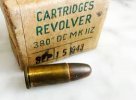
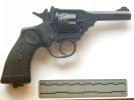
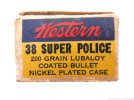
In 1937, the British Army lead-bullet MkI cartridge was replaced by the 178-grain FMJ Mk2 cartridge, to comply with the 1899 Hague Declaration. Remaining MkI cartridges were expended for marksmanship training and civilian law enforcement purposes. The .380 Mk.IIz cartridge with 178-grain FMJ bullet is still loaded by FN, Fiocchi and the India Ordnance Factories. Postwar commercial production Webley Mk. IV revolvers remained in service with police in Britain, Jordan, Israel, Canada, Hong Kong, Singapore, and Australia well into the 1980's, and may still be found in Iraq, Pakistan, India and Afghanistan.
US commercial .38 S&W ammunition with 146-grain lead round-nosed bullet is appropriate. Point of impact relative to point of aim may vary, depending upon which ammunition was used to target the revolver at the factory, and which detachable front sight blade is installed. With proper ammunition the Webley Mark IV is surprisingly accurate. Out test example, made in the 1950s, produces hand-held, golf ball sized 12-shot groups at 7 yards in firing the various ammos through the chronograph. Whilst revolvers guns made for the British commercial market had high polished blue and interchangeable, pinned in front sight blades, this postwar export example has typical military matte black oxide finish, lanyard loop, solid front sight machined integral with the barrel, and bears Israeli acceptance stamps. Its sights are correct for elevation with 146-grain Fiocchi ammunition or handloads with 148-grain swaged HBWC bullets seated to 1.15" OAL with 2.5 grains of Bullseye. The Mark IV .38 is a pleasant, accurate and satisfying shooter and great classic revolver.
